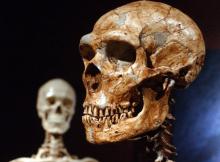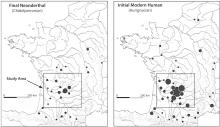As a companion piece to my earlier article on "inter-special breeding" between early Modern Humans and Neanderthals, a new report shows that sheer numbers of early modern humans may have pushed out, over-taken, or destroyed much of the Neanderthal population in France, which is the largest archeological site for this period in hominid history. The period, roughly between 35,000 and 45,000 years ago as human populations migrated out of the African Continent thousands of years after Neanderthal populations had already braved the colder northern wastes of the "mini ice age". What's unclear is how these two populations interacted. Were they peaceable? After all, there's been genetic evidence to suggest that there was the two peoples mated (primarily in the Middle East before migrating further). Did they fight for land, territory, or resources? Was the decline of the Neanderthal enough removed from the rise of early humans that by the time they arrived in Europe, their predecessors were ghost stories? New evidence may have, at least partially, and answer to these questions.
According to a recent report in Science via Ars Technica, early humans may have significantly outnumbered their Neanderthal cousins. Based on data pulled from a large density of archeological sites in southern France, two Cambridge researchers have managed to piece together rough population extrapolations using several metrics. The results show that early Cro-Magnon and Human populations inhabited sites sometimes more than three-times the size of Neanderthal sites, and often the human sites were simply Neanderthal sites that had been reinhabited. Neanderthal sites averaged 200 square meters in which the early hominid populations lived and conducted most of their activities. Human encampments, on the other hand, would average between 400 and 600 square meters, indicated a much larger number of individuals.
Additionally, the number of stone tools, implements, and other artifacts between the two different populations indicate a vast difference in the size and productivity of the two peoples. The timeline in question rests between two significant ages; the Chatelperronian era in which the last vestiges of the Neanderthal race was dominant, and the Aurignacian period, which was dominated by early modern humans. Between the Chatelperronian and the Aurignacian periods the densities of stone tools and animals remains at the sites increased dramatically, indicating that Neanderthals were vastly outnumbered by humans; possibly by a factor of 9 to 1.
Although this does not indicate specifics of how the two hominid species interacted or related contemporarily, it does give significant evidence to the fact the humans were a much more productive and successful race than Neanderthals, and that sheerly by dint of size they may have been dislocated, or possibly forcefully removed from this region of Europe. In addition to earlier evidence that there had been inter-breeding between the two species of hominid, there is no evidence that the two groups ever cohabited. Could the mating merely have been a byproduct of war as Neanderthal females were raped by marauding humans as they were forcibly driven from their territories? Could there have been instances where Neanderthal and human populations did live symbiotically and peaceably? Could it be that Neanderthals were simply bred out of existence, assimilated into the human genetic line? Likely it was a combination of all of the above, but only further study (and a good dose of imagination) will ever clarify this critical period in human history.

